– 1 April, 2018
Hayward's reverential hyperrealist renderings are so convincing, in moments you have to touch them in order to test if they are 'real' or not. Not that you're supposed to. I found myself gently knocking a brown painted wooden 'swappa crate' beer bottle with my knuckle to listen to the sound. The devotional labour invested in his finely detailed replicas of everyday things—fabricated found objects—read like the workings of a genius and/or madman.
Glen Hayward is a dendromaniac. Though an obsession with trees is not an entirely representative term for his practice, it is nonetheless compelling. Though Hayward is captivated by wood and its potential as a material (more than trees as subjects), I can almost feel the forest in his work. I imagine a wilderness or hinterland as the inspiration for his latest iterative sculpture, dendrochronology at Objectspace, or perhaps the woods as a new location for its installation: a Toyota Corolla—abandoned or stolen—an apparent playground for adults or children in a forest frequented by fringe dwellers.
Dendrochronology refers to the scientific study of tree rings or ‘growth rings’, determining the year they were formed in order to analyse atmospheric conditions during different historical periods. I came across this term recently when writing a review of Nicholas Mangan‘s exhibition at the Dowse, where in one video work, Ancient Lights (2015), the artist cites the research of Soviet-era Russian scientist Alexander Chizhevsky. Chizhevsky was a biophysicist who founded heliobiology (the study of the sun’s effects on biology), and also a painter and poet.
Chizhevsky used dendochronology to propose a controversial link between historical episodes of collective human activity (such as social revolution, insurrection, war and mass migration) and solar cycles which produce changes in the sun’s magnetic energy. He widened his research on sunspot-related solar flares to allegedly effect not only electrical usage, plane crashes, epidemics and grasshopper infestations, but also human mental life. Too woo-woo for you?
It was too weird for Stalin, given Chizhevsky’s radical proposition didn’t agree with his conceptions of the Russian revolutions of 1905 and 1917. After Chizhevsky failed to retract his ideas he was imprisoned in a forced labour gulag for eight years, then ‘rehabilitated’ for a further eight. His health suffered gravely, and though he managed to regain freedom, contribute further research and clear his name soon before he passed, Chizhevsky’s example supports the idea that you often die for being right too soon. The second mouse gets the cheese. Indeed, believe it or not, several more contemporary studies appear to support his conclusions.
While we’re discussing the politics of fringe ideas, conventional science is slowly coming around to the idea of plant consciousness—a concept once investigated by botanical parapsychologists—now convincingly demonstrated in our evolving understanding of the sophisticated ways in which plants communicate and interact with each other and their environment. In brief, plants demonstrate forms of advanced distributed consciousness without the need for an individual brain. They act in networks. The internet of plants or ‘wood wide web’, if you will. And in spite of them bearing silent witness to the heights and horrors of human history, and this emerging understanding of their advanced consciousness—or perhaps as a consequence—they give us their bodies as raw material.
Hayward often refers to his work in this material as carving and not sculpture, connecting them with ancient human traditions both utilitarian and transcendent. Jesus was a carpenter after all. I find myself writing this on the day that artist was crucified on a wooden cross for living and teaching love. I hope the text makes it online before he’s resurrected on Sunday, not that he ever went offline. Jesus is a conceptual art work.
Hayward’s reverential hyperrealist renderings are so convincing, in moments you have to touch them in order to test if they are ‘real’ or not. Not that you’re supposed to. I found myself gently knocking a brown painted wooden ‘swappa crate’ beer bottle with my knuckle to listen to the sound. This is also testament to Hayward’s skill as a kind of realist painter. The devotional labour invested in his finely detailed replicas of everyday things—fabricated found objects—read like the workings of a genius and/or madman. With Hayward there is a kind of mania at work. Hard work.
Encountering dendrochronology for the first time I felt like a young child again. A child beginning to discover the magical world of adults—no longer the Gods of an expanding world—now more rounded, flawed, fascinating. The rain soaked pornographic magazine found down by the river. The empty beer bottle and cigarette butt remnants of adult ecstasy and escapism in an abandoned car stripped bare by her bachelors.
During my second visit I was on the phone to a friend, listening and at times recounting my exhibition experience while circling the car for what felt like an hour, discovering new details within the intimate confines of the rear Chartwell Gallery. It felt like being in a car port, pressed to the walls by the automobile at the centre of the room for which it was designed.
The sculpture’s exhibition in more expansive spaces—Dunedin Public Art Gallery and Sydney Contemporary at Carriageworks (see Lucinda Bennett’s essay), also alter its interpretations. Hayward’s Objectspace installation sees the sculpture raised on cast cinderblocks made of wood and glue, but this time in a conventional orientation. Exhibited vertically at other venues, perched on its side, it appears to evolve and be remixed over time. Here, for example, there are also letters painted over on the found wooden sign used to fabricate the car boot, to form new words.
Splatters of white paint as bird shit on grey seats. Dripping fibreglass seals prime joins between recycled panels, their white, cream, pastel blue and pink hues forever awaiting a top coat. Finally unfinished.
It reads as a faux-expressionist object. The paint markings simulate those made by the automotive industry, or the stuff of life, and not ostensibly those of an artist intent on communicating inner states of being—or do they?
While the car’s interior is meticulously reproduced in typical Hayward style, the exterior is so boxy it wouldn’t even pass for a Volvo. It is unconvincing as anything other than art. The hardboard panels are rough and punctured, with hand written notes in black marker indicating “more rust”, while others denote the locations of a “screw” or “tape”. It even bears freight labels for Carriageworks and Paul Nache gallery. It is deconstruction as much as reconstruction: fitting, considering the car appears to await either refurbishment, or more likely, a grim fate courtesy of a wrecking yard. In the meantime, it appears as a problematic playground for adults and children alike.
I learn the work is a reference to a car the artist played in as a child, found abandoned within a paddock in Whanganui. The re-creation of a memory. I imagine it teeming with life. The car roof is sunken. A wooden window winder has broken off and been placed on the dashboard. Carved cigarette butts and Heineken bottle caps litter the interior, alongside an old cassette tape, a broken headrest lying on the back seat, a cow skull on the floor of the passenger’s side and a white plastic meat tray on the driver’s. A snail rests on a hand painted synthetic wood grain panel on the dashboard, reappearing in a concurrent installation inside Te Uru Waitakere Contemporary Gallery’s window space. They are material remnants of the activities and inner states of its absent inhabitants, anticipating the wonder of a child’s imagination.
dendrochronology represents a departure from how we might have come to understand Hayward’s work, particularly through these deconstructive gestures. Using an expanded vocabulary of local vernacular, here the artist appears to wrestle free from these more conventional understandings of his work in an energetic and cavalier fashion, answered by a neverending garage project.
Emil McAvoy
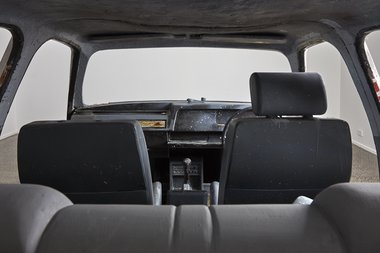
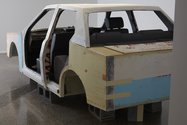
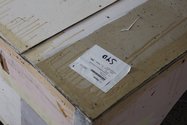
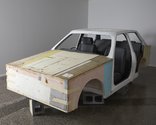
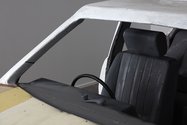

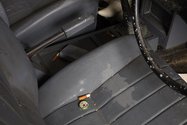
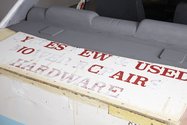

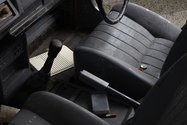


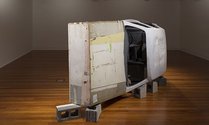
 Advertising in this column
Advertising in this column Two Rooms presents a program of residencies and projects
Two Rooms presents a program of residencies and projects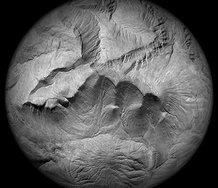
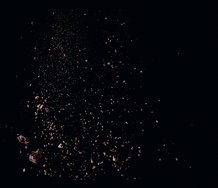

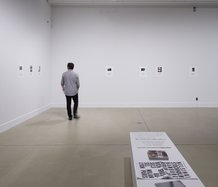
This Discussion has 0 comments.
Comment
Participate
Register to Participate.
Sign in
Sign in to an existing account.